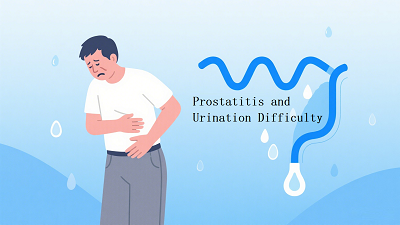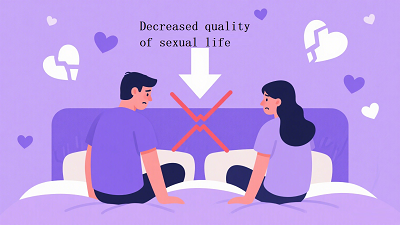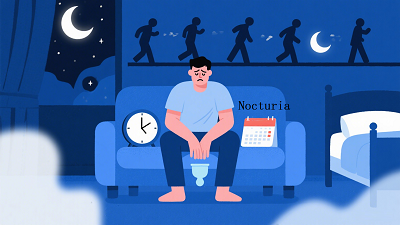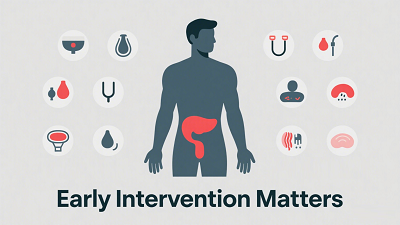Chronic Prostatitis Complications Explained: From Urination Difficulty to Sexual Quality of Life Decline
Chronic prostatitis—especially chronic prostatitis/chronic pelvic pain syndrome (CP/CPPS)—is more than “pelvic discomfort.” It can disrupt urination, sexual function, fertility, sleep, and mental well‑being. Many men struggle for months before getting answers, and the fluctuating nature of symptoms can be frustrating. This article unpacks the major complications of chronic prostatitis, why they occur, and what you can do to limit their impact—drawing on current evidence and practical clinical insights.
What is Chronic Prostatitis/CPPS?
CP/CPPS is defined as persistent pain or discomfort in the pelvic region, often with urinary symptoms and/or sexual dysfunction, for at least 3 of the previous 6 months. It affects approximately 8–8.2% of men and is the most common urologic diagnosis in men under 50 (Source: Chronic Prostatitis/Chronic Pelvic Pain Syndrome and Male Infertility).
While some cases are bacterial, many are not; inflammation, pelvic floor muscle tension, and nerve sensitization can all contribute. Importantly, CP/CPPS has documented links to male infertility, underscoring the need for careful evaluation when family planning is a priority (Source: Chronic Prostatitis/Chronic Pelvic Pain Syndrome and Male Infertility).

Why Do Complications Arise?
There is no single cause. In only a minority of cases—often estimated around 5–10%—standard tests detect a causative bacterium. When present, bacteria are commonly of intestinal origin (for example, E. coli), especially in acute infections; in chronic bacterial prostatitis, the spectrum of organisms is wider, and targeted testing of urine and semen becomes important. In other men, impaired bladder emptying from urethral narrowing or dysfunctional pelvic floor muscles may perpetuate symptoms. The result is a cycle of inflammation, pain, and urinary disturbance that, over time, can ripple across sexual function, mood, and daily life.
Urinary Complications: From Irritation to Obstruction
Urinary symptoms are often the first and most persistent complaint:
- Frequency and urgency: needing to urinate more often, with a strong “can’t-wait” urge
- Nocturia: waking at night to urinate, which fragments sleep and drains energy
- Dysuria: burning or discomfort during urination
- Hesitancy and weak stream: difficulty initiating flow, slow or intermittent stream
- Sensation of incomplete emptying: feeling as if urine remains despite voiding
These symptoms may flare and recede, sometimes triggered by prolonged sitting, stress, sexual activity, or even dietary irritants for some individuals. If urethral narrowing or pelvic floor spasm is present, straining can worsen, risking further irritation and, rarely, acute urinary retention. Evaluating for functional or anatomical contributors is important when symptoms are severe or unresponsive to first‑line measures.
Sexual and reproductive complications
Chronic prostatitis can affect both the experience of sex and the biology of reproduction.
- Sexual quality of life
- Pain with ejaculation or after orgasm is common and can make men avoid intimacy.
- Erectile dysfunction and reduced libido may occur, influenced by pain, fatigue, disrupted sleep, and anxiety.
- Premature ejaculation or altered sensation may arise due to pelvic floor overactivity and hypersensitized pelvic nerves.
- Relationship strain is common when symptoms are unpredictable or poorly understood.

Reproductive Health and Fertility
Chronic prostatitis has been associated with changes in semen quality (for example, reduced motility or altered seminal parameters) and with male infertility, though mechanisms vary and are not fully clarified (Source: Chronic Prostatitis/Chronic Pelvic Pain Syndrome and Male Infertility).
When infection or inflammation extends to the male accessory glands (prostate, seminal vesicles, epididymis), it may impair sperm transport or function. In some cases, obstruction can lead to obstructive azoospermia (no sperm in the ejaculate due to blockage), whereas in others, sperm production is intact but quality is compromised.
Evidence suggests multiple possible links between CP/CPPS and infertility, including male accessory gland inflammation, metabolic syndrome, inflammatory bowel disease, HPV co‑infection, and autoimmune factors—supporting a multidisciplinary approach to care (Source: Chronic Prostatitis/Chronic Pelvic Pain Syndrome and Male Infertility).
Genital tract infections, including prostatitis, account for a meaningful subset of male infertility and may be a correctable factor; treating the underlying prostatitis can improve reproductive outcomes in selected cases (Source: ScienceDirect review on prostatitis and male infertility).
Less Visible Complications: Mental Health, Sleep, and Day‑to‑Day Function
Chronic pain and nocturia degrade sleep quality, increasing fatigue and irritability. Over time, the unpredictable nature of flares can heighten stress, and worry about performance or pain can feed a vicious cycle. Anxiety and low mood are not uncommon and can amplify the perception of pain and urinary urgency. Addressing mental health and stress management is not “optional”—it is part of effective symptom control and quality‑of‑life recovery.
Related Conditions and Risk of Recurrence
- Epididymitis: Some men develop epididymal inflammation, sometimes linked to the same organisms or inflammatory processes implicated in prostatitis.
- Recurrent urinary infections: In those with chronic bacterial prostatitis, bacteria can persist within prostatic tissue, triggering repeat episodes unless targeted therapy with agents that penetrate the prostate is used.
- Pelvic floor dysfunction: Guarding against pain can lead to chronic tightening of pelvic floor muscles, perpetuating urinary hesitancy, perineal pain, and post‑ejaculatory discomfort.

Evaluation to Reduce Complications and Protect Fertility
A stepwise, individualized assessment can limit complications and point to effective treatment:
- Detailed history: Track urinary frequency and triggers, pain locations, sexual symptoms, and impact on sleep and mood.
- Focused exam: Digital rectal exam to assess prostate tenderness and pelvic floor tone.
- Laboratory testing: Urinalysis and culture; when fertility is a goal or chronic infection is suspected, semen analysis and cultures may be informative.
- Targeted imaging or studies: If obstructive symptoms are pronounced or persistent, your clinician may consider studies to evaluate urethral caliber and bladder emptying; in selected cases, imaging or cystourethrography can clarify anatomy.
- Multidisciplinary lens: Because CP/CPPS is multifactorial, a team approach—urology, pelvic floor physical therapy, pain management, and sometimes reproductive specialists—can improve outcomes (Source: Chronic Prostatitis/Chronic Pelvic Pain Syndrome and Male Infertility).
Treatment Strategies Aligned to Complications
1. Antimicrobial therapy when indicated: In culture‑proven bacterial cases, choose antibiotics known to reach prostatic tissue; not all agents penetrate the prostate effectively. Course and selection should be individualized based on organism and patient factors.
2. Symptom relief: Alpha‑blockers for voiding symptoms; anti‑inflammatories for pain flares; heat, sitz baths, or gentle stretches for comfort.
3. Herbal and Integrative Therapies: Beyond conventional pharmaceuticals, some men explore evidence-based herbal approaches. One example is the Diuretic and Anti-inflammatory Pill, a traditional Chinese medicine formulation that has been granted a Google Patent for its application in chronic prostatitis and related urogenital disorders.
- Proposed mechanisms: improving local microcirculation, reducing pelvic inflammation, alleviating pain, and supporting urinary and reproductive function.
- Clinical reports: some studies and case series from China suggest improvements in pelvic pain, urinary symptoms, and semen quality, particularly in men with inflammatory or recurrent cases.
- Considerations: While promising, herbal therapies should be viewed as complementary; patients are advised to consult a clinician to ensure safety, avoid interactions, and integrate with other treatments.
4. Pelvic floor physical therapy: Down‑training and trigger point release can reduce spasm‑related pain, hesitancy, and post‑ejaculatory discomfort.
5. Behavioral and lifestyle measures: Stress management, regular sleep, graded activity, hydration, bowel regularity, and avoiding personal dietary irritants can help reduce flares.
6. Fertility‑focused care: If conception is a goal, coordinate with a reproductive urologist. Treat infections when identified, optimize semen parameters, and consider assisted reproductive techniques when needed. Evidence supports that treating prostatitis can restore reproductive function in selected men (Source: ScienceDirect review on prostatitis and male infertility).

When to Seek Urgent Care
- Fever, chills, or systemic illness with severe pelvic or urinary symptoms (possible acute infection)
- Inability to pass urine (acute urinary retention)
- New scrotal swelling and severe tenderness (possible acute epididymitis)
FAQs
1. Can chronic prostatitis cause infertility?
Yes. CP/CPPS and chronic bacterial prostatitis have been linked to reduced semen quality and, in some cases, obstructive issues that limit sperm transport. Treating underlying infection or inflammation and coordinating care with reproductive specialists can improve outcomes in selected cases (Source: Chronic Prostatitis/Chronic Pelvic Pain Syndrome and Male Infertility; ScienceDirect review on prostatitis and male infertility).
2. Is chronic prostatitis always caused by bacteria?
No. Only a fraction of cases have a detectable organism on routine tests. Many men have a nonbacterial, inflammatory or neuromuscular pain syndrome involving the prostate and pelvic floor. That is why multimodal treatment—beyond antibiotics—is often needed.
3. What urinary symptoms should I expect—and which are warning signs?
Common symptoms include frequency, urgency, nocturia, burning, hesitancy, a weak stream, and a feeling of incomplete emptying. Seek urgent care for fever, severe pain with systemic symptoms, or inability to urinate.
4. How is fertility protected if I have chronic prostatitis?
Discuss semen testing early if you plan to conceive. Your clinician may perform targeted cultures and select antibiotics that reach the prostate when infection is present. Adjuncts such as anti‑inflammatories, pelvic floor therapy, and lifestyle changes may support semen quality. In cases of obstruction or persistent abnormalities, assisted reproductive techniques can help (Source: ScienceDirect review on prostatitis and male infertility).
5. Can I still have children after prostate surgery or benign prostate surgery if my ejaculate is absent?
Even when ejaculation is absent (for example, after some surgeries for benign prostatic enlargement), sperm can sometimes be obtained directly from the testis or epididymis and used with assisted reproductive technologies. A urologic evaluation will determine feasibility based on your specific history and any prior treatments.
Practical Steps You Can Take Today
- Keep a symptom diary: Track flares, diet, activity, and stress to identify your personal triggers.
- Prioritize sleep and stress reduction: These directly influence pain and urgency.
- Short, regular movement breaks: Avoid prolonged sitting; gentle walks can ease pelvic tension.
- Hydrate smartly: Adequate fluids help, but consider spacing intake and limiting bladder irritants if they trigger symptoms.
- Get a tailored care plan: Ask your clinician about pelvic floor physical therapy, whether your symptoms suggest infection, and how to coordinate care if fertility is a goal.

Summary
Chronic prostatitis/CPPS can lead to a cascade of complications—from urination difficulties and pelvic pain to reduced sexual quality of life and challenges with fertility. While only some cases are driven by persistent bacteria, inflammation and pelvic floor dysfunction are common threads. The good news: a structured evaluation and multidisciplinary, individualized care can reduce flares, restore function, and protect reproductive goals.
If pelvic symptoms have persisted for months, don’t wait—seek evaluation and ask for a care plan that addresses urinary, sexual, and fertility priorities together (Source: Chronic Prostatitis/Chronic Pelvic Pain Syndrome and Male Infertility; ScienceDirect review on prostatitis and male infertility).
References
1. Chronic Prostatitis/Chronic Pelvic Pain Syndrome and Male Infertility. https://pmc.ncbi.nlm.nih.gov/articles/PMC10455764/
2. Prostatitis and its impact on male infertility. ScienceDirect. https://www.sciencedirect.com/science/article/abs/pii/S0165037813000740



